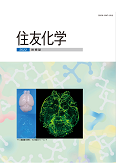FY 2022
2022.7.31 issue
-
In recent years, many efforts have been discussed and implemented around the world to achieve the Sustainable Development Goals (SDGs). The widespread use of fossil fuel-free electric vehicles (EVs) is essential for solving energy and climate change issues, which is one of the 17 SDGs. Our product, named Pervio, is an Aramid Coated Separator (ACS) for lithium-ion batteries (LIBs) that is used in EV batteries, and there is a possibility that it may improve safety. In this paper, we report on the functions and features of our ACS in LIBs.
(by Ichiro ARISE, Tomoaki OZEKI, Yuto MIYAHARA, Kohei MIYAZAKI, Takeshi ABE)
-
Ever since the successful synthesis of polypropylene by G. Natta et al. in 1954, the catalyst has gradually been refined along with significant improvement and simplification of the production process. The role of the donors used as a catalytic component or external donors in improving the polymerization activity and controlling the structure of polypropylene is very significant. In this article, we focus on the development trend of donors to explain changes in catalysts for propylene polymerization and their current status.
(by Masayuki HASEGAWA)
-
Rational optimization of low molecular weight compounds by chemical analoging and modern formulation technology enables vaccine adjuvants to have limited systemic bioavailability and remain localized for optimal safety and efficacy profiles. We have successfully discovered novel TLR7 vaccine adjuvants, DSP-0546E and DSP-0546LP, based on our expertise in non-clinical and clinical studies of TLR7 agonists. A universal influenza vaccine and several malaria vaccine candidates have been developed in combination with promising antigens designed by adopting the latest approaches, e.g., Reverse Vaccinology 2.0. We are eager to move forward with the research and development of next generation vaccines through collaborative innovation using our new ground-breaking adjuvant technology, in an effort to contribute to pandemic preparedness and global health.
(by Akihisa FUKUSHIMA)
-
To design and develop appropriate operating conditions and the safety system of a chemical production process, it is important to obtain accurate reaction kinetics of the thermal decomposition of the materials dealt with in the process. Thermal analyses using an ARC (Accelerating Rate Calorimeter) have been used to acquire the decomposition kinetics of chemical substances. However,thermal analysis using an ARC is inappropriate in some cases, such as when the latent heat of melting affects the exothermic heat flow or when the heat generation behavior exceeds the adiabatic control limit of the device. In this paper, several examples of applying the Friedman method (model-free kinetic analysis) using sealed cell DSC and C80 data in chemical process which solves several difficulties of reaction kinetics measurement and analysis are introduced.
(by Ryotaro ITOH)
-
Since an application for the approval of an Active Substance (AS) shall include a dossier on the AS together with a dossier on at least one product, under both the Plant Protection Product (PPP) Directive 91/414/EEC and the Biocidal Product (BP) Directive 98/8/EC, information on co-formulants/non-active substances contained in products was required. Such information is also required under the PPP Regulation 1107/2009 and the BP Regulation 528/2012. In this article, required information on co-formulants/non-active substances contained in PPPs or BPs, impact on the authorisation of products that may be brought about by concerns related to the coformulants/non-active substances, etc. are summarised.
(by Hiroko HARADA, Mio TATSU, Mika OTA)
